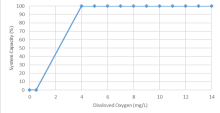Dissolved Oxygen and Salish Sucker System Capacity
mbakken
View all records in the stressor response library
Species Common Name
Salish Sucker
Latin Name (Genus species)
Catostomus sp.
Stressor Name
Dissolved Oxygen
Stressor Units
mg/L
Vital Rate (Process)
Specific growth rate
Geography
Lower Fraser Valley (British Columbia)
Detailed SR Function Description
The effects of DO on system capacity was mainly inferred based on a meta-analysis examining the effect of Dissolved Oxygen (DO) concentration on specific growth rate of fish, which evaluated data from 38 studies on 30 freshwater and marine species (Rosenfeld and Lee 2022). The shape of the curve and threshold value (5.1 mg/L) is based on segmented regression of specific growth rate as a function of dissolved oxygen averaged across 30 species. The inference implicit in using growth as the response variable is that threshold effects of low DO on individual growth will be similar to population-level effects. Although the average segmented regression across all species is highly significant and the threshold or 5.1 mg/L is consistent with previous analyses and regulatory guidelines for water quality, there remains great inter-specific variation around the mean response. Salish sucker is not a cold-water species and therefore, less sensitive to hypoxia compared to salmonids (Rosenfeld et al. 2021; Zinn et al. 2021). Based on observation and experience, and the assumption that Salish sucker are selected for some degree of hypoxia tolerance because they have evolved in small streams subject to seasonal drying and low flows (and also prefer deep pool or wetland habitat that is subject to intermittent hypoxia), the threshold DO for sublethal effects on Salish sucker has been set at 4 mg/L (Fisheries and Oceans Canada 2019). We set the x-intercept at 0.5 mg/L to reflect the higher known tolerance of Salish sucker compared to salmonids (x-intercept ≈ 3 mg/L) and the average across all species (0.8 mg/l DO; Rosenfeld et al. 2021, Rosenfeld and Lee 2022). The habitat suitability index model for Longnose Sucker (Edwards, 1983) generally supports the shape of the function, but has a higher threshold (6 mg/L) and x-intercept (4.5 mg/L), reflecting the fact that Longnose sucker (the sister-species to Salish sucker) are a cool-water species.
Function Derivation
Based on data from other species; Empirical data (correlative model); Published
Transferability of Function
As local adaptations are likely minimal among different Salish Sucker populations, we would not expect much variation in true tolerance among populations. This function should therefore be broadly applicable to all populations of the species, with the caveat that it is partly based on data from other related species.
Source of stressor Data
DO data is available for several reaches in Bertrand, Pepin, Fishtrap Creeks, and the Salmon River, collected as part of reconnaissance surveys to assess fish distribution, monitoring associated with habitat restoration, and mark–recapture population assessments that took place between 2003 and 2018. A predictive model to estimate DO as a function of temperature, flow, and associated covariates will need to be generated to create the dissolved oxygen stressor dataset.
Function Type
continuous
Stressor Scale
linear
References Cited
Usoof, A.M. and Rosenfeld, J.S. 2024. Relationship between system capacity and Dissolved Oxygen concentration for Nooksack Dace.
Fisheries and Oceans Canada. 2019. Recovery strategy for the Salish Sucker ( Catostomus sp .) in Canada [Proposed]. 1st amendment. Species at Risk Act Recovery Strategy Series. Fisheries and Oceans Canada, Ottawa. vii - 78 pp.
Rosenfeld, J., and Lee, R. 2022. Thresholds for Reduction in Fish Growth and Consumption Due to Hypoxia: Implications for Water Quality Guidelines to Protect Aquatic Life. Envirnmental Manag. Springer US. doi:10.1007/s00267-022-01678-9.
Rosenfeld, J., Pearson, M.P., Miners, J., and Zinn, K. 2021. Effects of landscape-scale hypoxia on Salish sucker and salmonid habitat associations : implications for endangered. 1233(February): 1219–1233.
Zinn, K.R., Rosenfeld, J.S., and Taylor, E.B. 2021. Effects of experimental flow manipulations on water quality, hypoxia, and growth of threatened salish sucker (Catostomus sp. cf. catostomus) and juvenile coho salmon (oncorhynchus kisutch). Can. J. Fish. Aquat. Sci. 78(9): 1234–1246. doi:10.1139/cjfas-2020-0135.
Fisheries and Oceans Canada. 2019. Recovery strategy for the Salish Sucker ( Catostomus sp .) in Canada [Proposed]. 1st amendment. Species at Risk Act Recovery Strategy Series. Fisheries and Oceans Canada, Ottawa. vii - 78 pp.
Rosenfeld, J., and Lee, R. 2022. Thresholds for Reduction in Fish Growth and Consumption Due to Hypoxia: Implications for Water Quality Guidelines to Protect Aquatic Life. Envirnmental Manag. Springer US. doi:10.1007/s00267-022-01678-9.
Rosenfeld, J., Pearson, M.P., Miners, J., and Zinn, K. 2021. Effects of landscape-scale hypoxia on Salish sucker and salmonid habitat associations : implications for endangered. 1233(February): 1219–1233.
Zinn, K.R., Rosenfeld, J.S., and Taylor, E.B. 2021. Effects of experimental flow manipulations on water quality, hypoxia, and growth of threatened salish sucker (Catostomus sp. cf. catostomus) and juvenile coho salmon (oncorhynchus kisutch). Can. J. Fish. Aquat. Sci. 78(9): 1234–1246. doi:10.1139/cjfas-2020-0135.
File Upload
Stressor Response csv data
Data_SS_DO.csv
(254 bytes)
| DO (mg/L) | Mean System Capacity (%) | SD | low.limit | up.limit |
|---|---|---|---|---|
| 0 | 0 | 0 | 0 | 100 |
| 0.5 | 0 | 0 | 0 | 100 |
| 4 | 100 | 0 | 0 | 100 |
| 5 | 100 | 0 | 0 | 100 |
| 6 | 100 | 0 | 0 | 100 |
| 7 | 100 | 0 | 0 | 100 |
| 8 | 100 | 0 | 0 | 100 |
| 9 | 100 | 0 | 0 | 100 |
| 10 | 100 | 0 | 0 | 100 |
| 11 | 100 | 0 | 0 | 100 |
| 12 | 100 | 0 | 0 | 100 |
| 13 | 100 | 0 | 0 | 100 |
| 14 | 100 | 0 | 0 | 100 |
Stressor Response Chart

